Leonardo Neves
GraphHash: Graph Clustering Enables Parameter Efficiency in Recommender Systems
Dec 23, 2024Abstract:Deep recommender systems rely heavily on large embedding tables to handle high-cardinality categorical features such as user/item identifiers, and face significant memory constraints at scale. To tackle this challenge, hashing techniques are often employed to map multiple entities to the same embedding and thus reduce the size of the embedding tables. Concurrently, graph-based collaborative signals have emerged as powerful tools in recommender systems, yet their potential for optimizing embedding table reduction remains unexplored. This paper introduces GraphHash, the first graph-based approach that leverages modularity-based bipartite graph clustering on user-item interaction graphs to reduce embedding table sizes. We demonstrate that the modularity objective has a theoretical connection to message-passing, which provides a foundation for our method. By employing fast clustering algorithms, GraphHash serves as a computationally efficient proxy for message-passing during preprocessing and a plug-and-play graph-based alternative to traditional ID hashing. Extensive experiments show that GraphHash substantially outperforms diverse hashing baselines on both retrieval and click-through-rate prediction tasks. In particular, GraphHash achieves on average a 101.52% improvement in recall when reducing the embedding table size by more than 75%, highlighting the value of graph-based collaborative information for model reduction.
Enhancing Item Tokenization for Generative Recommendation through Self-Improvement
Dec 22, 2024



Abstract:Generative recommendation systems, driven by large language models (LLMs), present an innovative approach to predicting user preferences by modeling items as token sequences and generating recommendations in a generative manner. A critical challenge in this approach is the effective tokenization of items, ensuring that they are represented in a form compatible with LLMs. Current item tokenization methods include using text descriptions, numerical strings, or sequences of discrete tokens. While text-based representations integrate seamlessly with LLM tokenization, they are often too lengthy, leading to inefficiencies and complicating accurate generation. Numerical strings, while concise, lack semantic depth and fail to capture meaningful item relationships. Tokenizing items as sequences of newly defined tokens has gained traction, but it often requires external models or algorithms for token assignment. These external processes may not align with the LLM's internal pretrained tokenization schema, leading to inconsistencies and reduced model performance. To address these limitations, we propose a self-improving item tokenization method that allows the LLM to refine its own item tokenizations during training process. Our approach starts with item tokenizations generated by any external model and periodically adjusts these tokenizations based on the LLM's learned patterns. Such alignment process ensures consistency between the tokenization and the LLM's internal understanding of the items, leading to more accurate recommendations. Furthermore, our method is simple to implement and can be integrated as a plug-and-play enhancement into existing generative recommendation systems. Experimental results on multiple datasets and using various initial tokenization strategies demonstrate the effectiveness of our method, with an average improvement of 8\% in recommendation performance.
Explainability and Hate Speech: Structured Explanations Make Social Media Moderators Faster
Jun 06, 2024


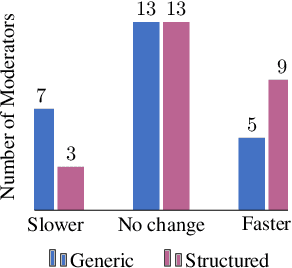
Abstract:Content moderators play a key role in keeping the conversation on social media healthy. While the high volume of content they need to judge represents a bottleneck to the moderation pipeline, no studies have explored how models could support them to make faster decisions. There is, by now, a vast body of research into detecting hate speech, sometimes explicitly motivated by a desire to help improve content moderation, but published research using real content moderators is scarce. In this work we investigate the effect of explanations on the speed of real-world moderators. Our experiments show that while generic explanations do not affect their speed and are often ignored, structured explanations lower moderators' decision making time by 7.4%.
USE: Dynamic User Modeling with Stateful Sequence Models
Mar 20, 2024



Abstract:User embeddings play a crucial role in user engagement forecasting and personalized services. Recent advances in sequence modeling have sparked interest in learning user embeddings from behavioral data. Yet behavior-based user embedding learning faces the unique challenge of dynamic user modeling. As users continuously interact with the apps, user embeddings should be periodically updated to account for users' recent and long-term behavior patterns. Existing methods highly rely on stateless sequence models that lack memory of historical behavior. They have to either discard historical data and use only the most recent data or reprocess the old and new data jointly. Both cases incur substantial computational overhead. To address this limitation, we introduce User Stateful Embedding (USE). USE generates user embeddings and reflects users' evolving behaviors without the need for exhaustive reprocessing by storing previous model states and revisiting them in the future. Furthermore, we introduce a novel training objective named future W-behavior prediction to transcend the limitations of next-token prediction by forecasting a broader horizon of upcoming user behaviors. By combining it with the Same User Prediction, a contrastive learning-based objective that predicts whether different segments of behavior sequences belong to the same user, we further improve the embeddings' distinctiveness and representativeness. We conducted experiments on 8 downstream tasks using Snapchat users' behavioral logs in both static (i.e., fixed user behavior sequences) and dynamic (i.e., periodically updated user behavior sequences) settings. We demonstrate USE's superior performance over established baselines. The results underscore USE's effectiveness and efficiency in integrating historical and recent user behavior sequences into user embeddings in dynamic user modeling.
Designing and Evaluating General-Purpose User Representations Based on Behavioral Logs from a Measurement Process Perspective: A Case Study with Snapchat
Dec 19, 2023Abstract:In human-computer interaction, understanding user behaviors and tailoring systems accordingly is pivotal. To this end, general-purpose user representation learning based on behavior logs is emerging as a powerful tool in user modeling, offering adaptability to various downstream tasks such as item recommendations and ad conversion prediction, without the need to fine-tune the upstream user model. While this methodology has shown promise in contexts like search engines and e-commerce platforms, its fit for instant messaging apps, a cornerstone of modern digital communication, remains largely uncharted. These apps, with their distinct interaction patterns, data structures, and user expectations, necessitate specialized attention. We explore this user modeling approach with Snapchat data as a case study. Furthermore, we introduce a novel design and evaluation framework rooted in the principles of the Measurement Process Framework from social science research methodology. Using this new framework, we design a Transformer-based user model that can produce high-quality general-purpose user representations for instant messaging platforms like Snapchat.
SuperTweetEval: A Challenging, Unified and Heterogeneous Benchmark for Social Media NLP Research
Oct 23, 2023Abstract:Despite its relevance, the maturity of NLP for social media pales in comparison with general-purpose models, metrics and benchmarks. This fragmented landscape makes it hard for the community to know, for instance, given a task, which is the best performing model and how it compares with others. To alleviate this issue, we introduce a unified benchmark for NLP evaluation in social media, SuperTweetEval, which includes a heterogeneous set of tasks and datasets combined, adapted and constructed from scratch. We benchmarked the performance of a wide range of models on SuperTweetEval and our results suggest that, despite the recent advances in language modelling, social media remains challenging.
Context-aware Adversarial Attack on Named Entity Recognition
Sep 16, 2023Abstract:In recent years, large pre-trained language models (PLMs) have achieved remarkable performance on many natural language processing benchmarks. Despite their success, prior studies have shown that PLMs are vulnerable to attacks from adversarial examples. In this work, we focus on the named entity recognition task and study context-aware adversarial attack methods to examine the model's robustness. Specifically, we propose perturbing the most informative words for recognizing entities to create adversarial examples and investigate different candidate replacement methods to generate natural and plausible adversarial examples. Experiments and analyses show that our methods are more effective in deceiving the model into making wrong predictions than strong baselines.
Tweet Insights: A Visualization Platform to Extract Temporal Insights from Twitter
Aug 04, 2023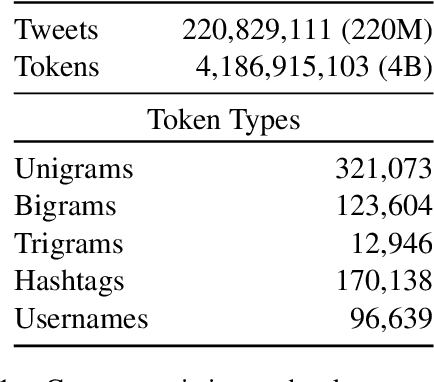
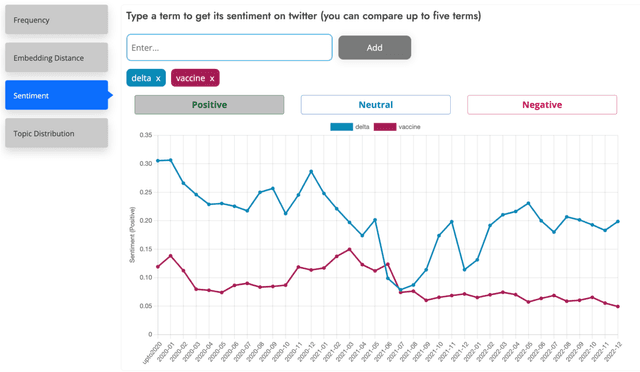
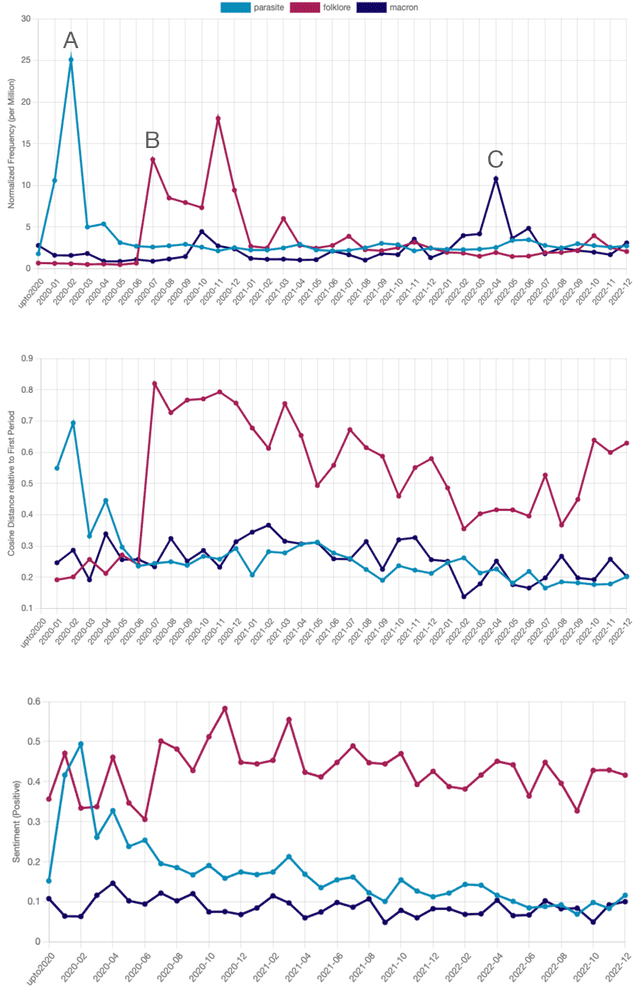
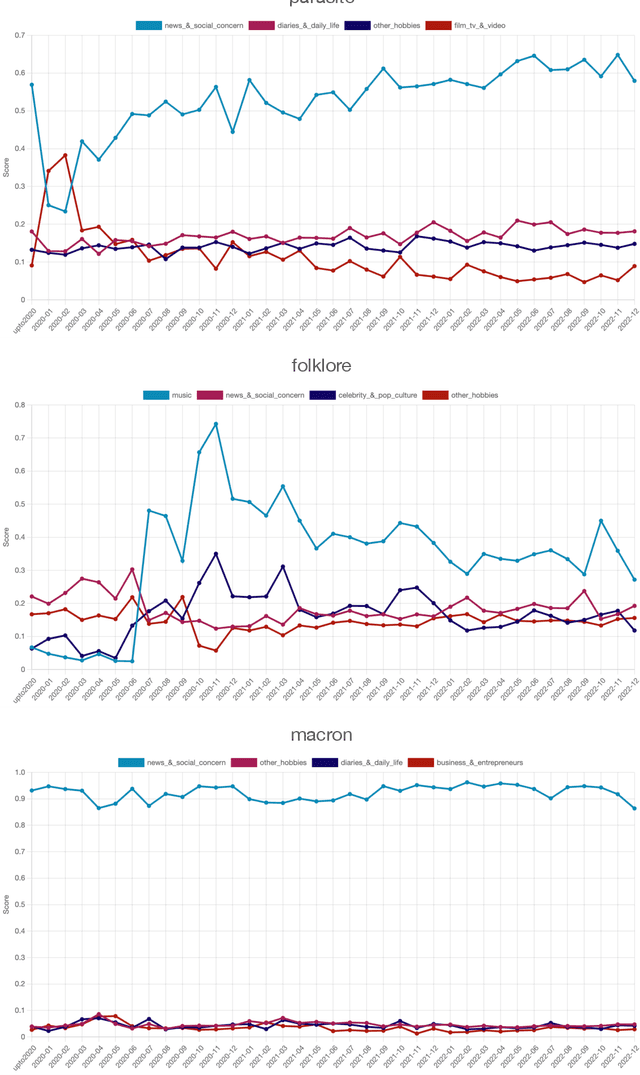
Abstract:This paper introduces a large collection of time series data derived from Twitter, postprocessed using word embedding techniques, as well as specialized fine-tuned language models. This data comprises the past five years and captures changes in n-gram frequency, similarity, sentiment and topic distribution. The interface built on top of this data enables temporal analysis for detecting and characterizing shifts in meaning, including complementary information to trending metrics, such as sentiment and topic association over time. We release an online demo for easy experimentation, and we share code and the underlying aggregated data for future work. In this paper, we also discuss three case studies unlocked thanks to our platform, showcasing its potential for temporal linguistic analysis.
Style Transfer as Data Augmentation: A Case Study on Named Entity Recognition
Oct 14, 2022



Abstract:In this work, we take the named entity recognition task in the English language as a case study and explore style transfer as a data augmentation method to increase the size and diversity of training data in low-resource scenarios. We propose a new method to effectively transform the text from a high-resource domain to a low-resource domain by changing its style-related attributes to generate synthetic data for training. Moreover, we design a constrained decoding algorithm along with a set of key ingredients for data selection to guarantee the generation of valid and coherent data. Experiments and analysis on five different domain pairs under different data regimes demonstrate that our approach can significantly improve results compared to current state-of-the-art data augmentation methods. Our approach is a practical solution to data scarcity, and we expect it to be applicable to other NLP tasks.
Named Entity Recognition in Twitter: A Dataset and Analysis on Short-Term Temporal Shifts
Oct 07, 2022

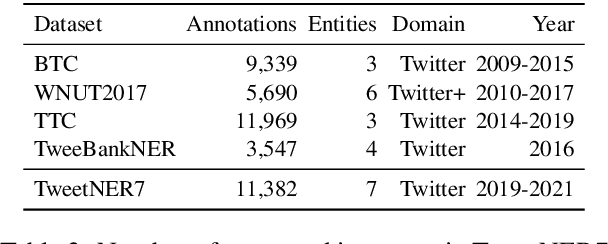

Abstract:Recent progress in language model pre-training has led to important improvements in Named Entity Recognition (NER). Nonetheless, this progress has been mainly tested in well-formatted documents such as news, Wikipedia, or scientific articles. In social media the landscape is different, in which it adds another layer of complexity due to its noisy and dynamic nature. In this paper, we focus on NER in Twitter, one of the largest social media platforms, and construct a new NER dataset, TweetNER7, which contains seven entity types annotated over 11,382 tweets from September 2019 to August 2021. The dataset was constructed by carefully distributing the tweets over time and taking representative trends as a basis. Along with the dataset, we provide a set of language model baselines and perform an analysis on the language model performance on the task, especially analyzing the impact of different time periods. In particular, we focus on three important temporal aspects in our analysis: short-term degradation of NER models over time, strategies to fine-tune a language model over different periods, and self-labeling as an alternative to lack of recently-labeled data. TweetNER7 is released publicly (https://huggingface.co/datasets/tner/tweetner7) along with the models fine-tuned on it (NER models have been integrated into TweetNLP and can be found athttps://github.com/asahi417/tner/tree/master/examples/tweetner7_paper).
 Add to Chrome
Add to Chrome Add to Firefox
Add to Firefox Add to Edge
Add to Edge